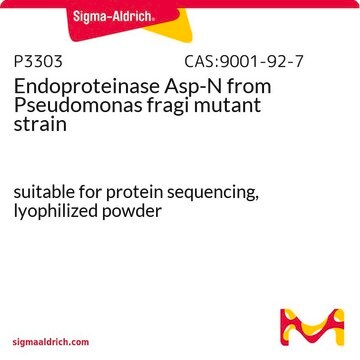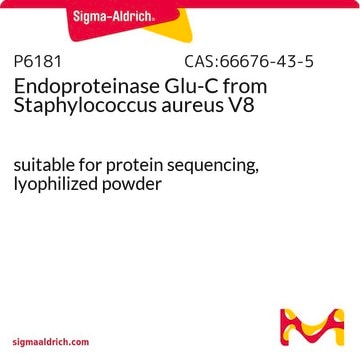324708
Endoproteinase Asp-N, Excision Grade, Pseudomonas fragi
Sinónimos:
Endoproteinase Asp-N, Excision Grade, Pseudomonas fragi
Iniciar sesiónpara Ver la Fijación de precios por contrato y de la organización
About This Item
Productos recomendados
General description
Native endoproteinase Asp-N from Pseudomonas fragi. Designed for protein sequencing or sequence verification, analysis of protein structural domains, and cleavage of fusion proteins. Metalloprotease that specifically hydrolyzes proteins and the N-terminal side of aspartic acid and cysteic acid residues. Inhibited by aprotinin, DFP, leupeptin, and TLCK.
Native endoproteinase Asp-N from Pseudomonas fragi. Designed for protein sequencing or sequence verification, analysis of protein structural domains, and cleavage of fusion proteins. Metalloprotease that specifically hydrolyzes proteins at the N-terminal side of aspartic acid and cysteic acid residues. Inhibited by aprotinin, DFP, leupeptin, and TLCK. Suggested working concentration: 1:20 to 1:100 (protease:protein by weight) for sequence analysis.
Warning
Toxicity: Harmful (C)
Unit Definition
One unit is defined as the amount of enzyme that will release a sufficient amount of azo dye from AZOCOLL Substrate (Cat. No. 194932) to produce an increase in absorbance at 520 nm of 0.001 per min at 37°C, pH 7.5.
Physical form
Lyophilized from 10 mM Tris-HCl, pH 7.5.
Reconstitution
Following reconstitution, aliquot and freeze (-20°C) for long term storage or refrigerate (4°C) for short term storage. Stock solutions are stable for up to 2 days at 4°C or for up to 1 month at -20°C.
Other Notes
Drapeau, G.R. 1980. J. Biol. Chem.255, 839.
Legal Information
CALBIOCHEM is a registered trademark of Merck KGaA, Darmstadt, Germany
signalword
Danger
hcodes
Hazard Classifications
Eye Irrit. 2 - Resp. Sens. 1 - Skin Irrit. 2 - STOT SE 3
target_organs
Respiratory system
Storage Class
11 - Combustible Solids
wgk_germany
WGK 1
Certificados de análisis (COA)
Busque Certificados de análisis (COA) introduciendo el número de lote del producto. Los números de lote se encuentran en la etiqueta del producto después de las palabras «Lot» o «Batch»
¿Ya tiene este producto?
Encuentre la documentación para los productos que ha comprado recientemente en la Biblioteca de documentos.
Nuestro equipo de científicos tiene experiencia en todas las áreas de investigación: Ciencias de la vida, Ciencia de los materiales, Síntesis química, Cromatografía, Analítica y muchas otras.
Póngase en contacto con el Servicio técnico








